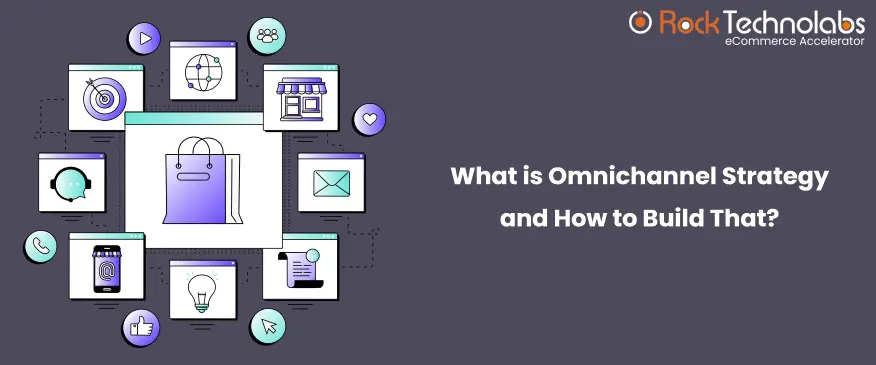What is Omnichannel Retail Strategy?

In today’s world, consumers have many options when shopping online and offline. From mobile apps to physical stores, customers can use their preferred channels to shop for products and services. Today’s consumers are becoming accustomed to multiple channels (mobile, ecommerce, social media, etc.) and want brands that meet their demands across these platforms.
This means companies must adopt omnichannel marketing strategies to succeed. In addition to the convenience, omnichannel strategies provide businesses with several advantages, including increased customer engagement and brand loyalty.
What is Omnichannel?
Omnichannel is arguably the most efficient approach to digital marketing, followed by most of the biggest brands. Omnichannel means delivering a consistent and seamless user experience across channels – websites, mobile apps, social media, etc.
What is an Omnichannel Retail Strategy?
Omnichannel strategy refers to any type of marketing strategy that takes advantage of the full range of methods available online and offline. Omnichannel strategy retail is a fully-integrated approach to commerce, supplying shoppers with a unified experience across all channels or touchpoints, by providing brands with a cohesive presence, may it be in a physical store, social media channel, or a virtual shopping experience.
Imagine a world where no matter where customers meet your brand, whether online or offline, you have the power to affect their buying decision-making. With an omnichannel retail strategy, brands no longer have to imagine that world.
To put things in perspective, omnichannel marketing means different things to different people. But have you ever thought that why brands take advantage of an omnichannel strategy? The answer is simple and that is to retain, gain, and engage with their customers.
To create an omnichannel strategy, marketers must understand how customers move through each channel. Each channel has its strengths and weaknesses—you don’t want to miss out on customer data or the opportunity to sell to them at various stages.
So, let’s dive into the techniques that have improved omnichannel customer experience for hundreds and thousands of businesses! But before that, let’s check the benefits of having an omnichannel strategy first.
Benefits of Omnichannel Strategy:
There are many advantages to implementing an omnichannel marketing strategy. Let’s take a look at them.
The main advantage of an omnichannel strategy is improved customer experience. Consumers can access information about a company’s products and services at any time and in any location. Since companies have multiple ways to interact with customers, they are able to improve conversion rates by providing exceptional customer experiences.
Businesses can benefit from an omnichannel strategy in three main ways. First, they can enhance customer service and increase satisfaction. Second, these strategies can help improve conversions. Third, they can help generate revenue through cross-selling opportunities.
1) Customer Service & Satisfaction
One way businesses can improve customer service and satisfaction is by offering a seamless customer journey throughout the entire purchasing process. For example, if someone purchases a product through a website, they might receive a follow-up email offering additional discounts and promotions.
The benefits of omnichannel customer service include branding, customer loyalty, trust, more sales, efficiency, quality, and flexibility.
2) Conversions
Companies can optimize their business processes to increase conversions. An omnichannel strategy offers companies an opportunity to capture data from different channels and analyze what works best for each customer. If it turns out that a particular channel doesn’t work well for a specific group of customers, then employees can make changes accordingly.
3) Cross-Selling Opportunities
Customers who buy products or services through a given channel may be interested in buying similar items in the future. By knowing this, businesses can offer customers incentives to purchase certain products or services.
4) Increased Customer Accessibility
Customers now have access to your business 24/7 via websites, mobile devices, email, text messaging, and social networking sites like Facebook and Twitter. You’ve probably heard the saying ‘the customer is always right, and that’s true. If the customer is happy with their experience, they’ll tell others about it, increasing word-of-mouth referrals.
5) Multiple Channels of Communication
Many companies have already mastered the art of using email and direct mail to send messages to their target audience. Now they are going beyond email and direct mail by leveraging the power of social media platforms. Social media gives businesses a platform where they can talk directly to consumers about products, services, promotions, and other information. From tweets to Facebook posts, businesses can share information and engage with customers.
6) Customized Messages
Each individual consumer receives personalized messages based on his or her interests and preferences. By tailoring content and frequency of communication according to each person, businesses can create stronger brand loyalty.
7) Improved Sales Conversion Rates
The goal is to make sure your company’s website contains everything a potential customer might need while on your site. A good example would be offering free shipping options, a guarantee of authenticity, or a quick return policy. All of these offer added value to the consumer and can encourage them to buy from you instead of your competitor.
If we look into some of the omnichannel strategy examples then there are big names on the list including Disney, Sephora, Target, Starbucks, etc. who are already taking advantage of omnichannel strategies by implementing some of the fantastic omnichannel experience.
So, How To Improve Omnichannel Customer Experience?
We have to focus on the benefits of an omnichannel strategy, but also look at the big picture to ensure that the customer’s entire journey is positive and memorable. Here are some tips and omnichannel strategies of top retailers:
Enhance The Mobile Experience
Mobile commerce is growing. Provide a great mobile app experience. You should be able to browse products while you’re on the go. Make sure your website looks good on mobile devices.
Personalized
Personalization is one of the key strategies that works. Add relevant data to your customers’ profiles. Use their preferences and past purchase history to personalize content and offers.
Use AI-powered Chatbots
Chatbots are becoming increasingly popular among brands today, particularly those that cater to ecommerce customers. By leveraging artificial intelligence (AI), these chatbots can interact with their users naturally without requiring any manual intervention. These bots have gained a lot of traction over the past few years, especially in industries where customer service is a priority. Not only do they provide highly optimized customer experiences, but they save time for employees and reduce operational costs.
Provide Real-time Product Information
In the age of digitalization, many shoppers prefer to shop online rather than going to brick-and-mortar stores. However, these days, they often find themselves confused about the differences between products online. Therefore, it’s important for retailers to ensure that their websites are able to answer questions and provide accurate product details for both existing and potential customers. Creating a great product detail page is a must. Also, having clear descriptions and images allow customers to easily identify what they need while shopping online.
Offer a Unique Customer Experience
Customers today want seamless and personalized experiences, whether in-store or online. While some companies offer great customer experience, others aren’t doing enough to differentiate themselves from competitors. Retailers should invest in developing innovative ways of engaging with customers by offering unique services and experiences. These may entail things like special offers, coupons, exclusive discounts, and even dedicated teams to serve customers on specific occasions.
Create a positive customer experience
Retailers need to create a positive customer experience. Customers don’t care how much money you spend on advertising if they feel neglected after the purchase. Hence, the retailer’s job isn’t just to sell the product. Rather, it is to create an emotional connection with consumers and give them memorable moments. In fact, studies show that the best customers leave happy memories, which means retailers should focus on providing a delightful shopping experience.
Leverage Omnichannel Marketing and Get The Best ROI:
Omnichannel sales enable retailers to reach out to customers at different touchpoints across various channels, such as voice, text, email, and social media. This enables retailers to connect with their consumers and build stronger relationships with them. As a result, consumers become loyal to the brand and more likely to make future purchases. Therefore, omnichannel marketing not only helps businesses in maintaining strong customer relationships; it also helps boost sales. Need consultation for omnichannel approach? Our team can help, contact us!
Omnichannel Frequently Asked Questions :
⦁ Target – partnered with Pinterest to integrate their functionality to Pinterest’s lens to offer a seamless experience to customers
⦁ Disney – The Champion of Omnichannel has My Disney Experience Tool and Magic Band offering great omnichannel experience to customers.





